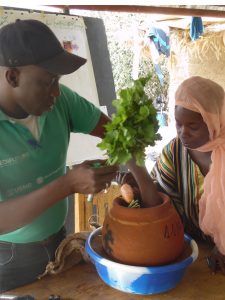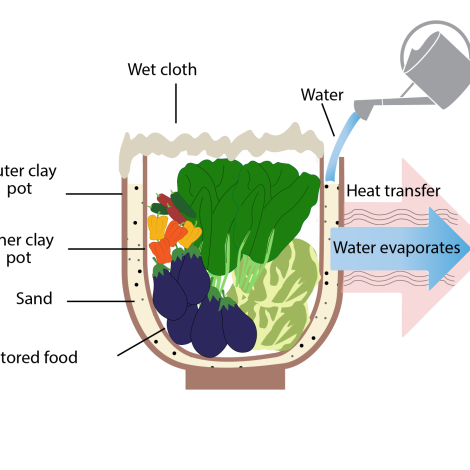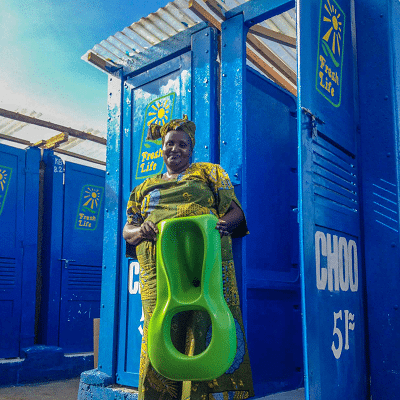
Djiguiba Boureima (left) and Kadidia Nienta demonstrate the use of a clay pot cooler at a training session at the Nyleni Cooperative Society in Mopti, Mali. Photo couretesy of Djiguiba Boureima
Fruits and vegetables can spoil quickly in arid climates, leading to the loss of food, time, and money. Roughly 50% of fruits and vegetables harvested in Sub-Saharan Africa are lost between harvest and reaching the consumer, owed in part to poor storage in regions where electricity is scarce or expensive. There is an inexpensive solution, however, and it’s relatively simple: a clay pot cooler. Clay pot coolers can increase the shelf life of many fruits and vegetables, including tomatoes, leafy greens, eggplant, and okra, among others.
These coolers take advantage of the evaporative-cooling effect. It works in the same way as perspiration, which evaporates to cool the human body. The evaporation of water from the outer surface of the clay pot removes heat and cools the fruits and vegetables inside. The inside of the pots can be as much as 10°C below the ambient temperature, with increased humidity to better preserve produce.
This simple device can improve food security and provide monetary and labor efficiencies for people in areas without access to other kinds of refrigeration. For example, the shelf life of leafy greens can be extended from approximately one day when left out at room temperature, to over four days when stored in a clay pot cooler, reducing the risk of food loss and allowing families to travel to a market twice a week instead of every day.
Simple to build
Clay pot coolers can be built several ways. A typical design is a smaller pot nested inside a larger cylindrical pot. Or a variation can be a pot placed in a plastic basin. The sizes of the pots can be selected based on what is most practical for a given user. Sand is placed between the inner pot and outer vessel, and a cloth or sack is placed over the cooler as a cover. Clay pot coolers can cost (USD) $5—$40, depending on their size and the cost of local materials. Regardless of the size and design, the best practices for using clay pot coolers include storing them in a shady and well-ventilated area, keeping the sand between the inner and outer pots wet, covering the cooler with a wet cloth or sack, and regularly cleaning the inside of the cooler.
The research underway
Since 2016, MIT D-Lab, the World Vegetable Center (WVC), and Institut d’Economie Rurale (IER) have collaborated to evaluate the suitability of clay pot coolers for household use in Mali, how the devices perform, how people use the devices, and the most effective approaches for disseminating the technology. While most people in Mali are familiar with the concept of using clay pots to keep water cool, research found that very few people were aware that two pots, some sand, and a covering could be assembled into a storage device that improves the shelf life of fruits and vegetables.
As part of an initial research study to evaluate the performance of clay pot coolers and understand user behavior, the team distributed assembled clay pot coolers to households with basic instructions for using the coolers to store their fruits and vegetables. Based on survey results, participants who used clay pot coolers reported reductions in food lost to spoilage, resulting in financial savings and increased availability of fruits and vegetables for their households. However, there was a lack of awareness about where the devices could be purchased or how to make the coolers themselves.
Guidebook: How to build, use and maintain a clay pot cooler
In an effort to bridge this gap, the team has developed “A Guide to Assembling, Using, and Maintaining Clay Pot Coolers” to disseminate information about this simple, low-cost technology with great potential to improve nutrition, and, in some cases, livelihoods. The guide is now available in English, Hindi, Swahili, French, Spanish, Bambara, Hausa and Zarma. Each version covers the following:
- How evaporative cooling works
- Importance of proper fruit and vegetable storage
- Types of clay pot coolers and how to assemble them
- Fruit and vegetable compatibility
- Best practices for using clay pot coolers
Training program in Mali
The team is using this guide as the centerpiece of an ongoing training program funded by the Innovation, Technology, & Research Hub at USAID and the Islamic Development Bank in the Mopti region of Mali. The approach we are taking in Mali is to start by sharing this information with agricultural extension agents and clay pot producers through in-depth training-of-trainers (ToT) sessions. The ToT participants will go on to conduct more focused trainings with larger groups of fruit and vegetable sellers, pot makers, farmers, and other community members.
About the Authors
Eric Verploegen joined MIT D-Lab in 2014 to expand D-Lab’s research efforts in the areas of food water and energy. His two main areas of work are related to evaporative cooling for vegetable preservation and D-Lab’s Energy Needs Assessment Toolkit, supporting organizations to identify the most pressing energy needs in the communities where they work.
Melissa Mangino is Senior Program Associate at MIT D-Lab where she provides administrative support for D-Lab academics and the Scale Ups program. In her previous life, Melissa was a high school social studies teacher and has many years of experience in K-12 education advocacy, community outreach, and engagement.


Very useful innovative way to cool vegetables